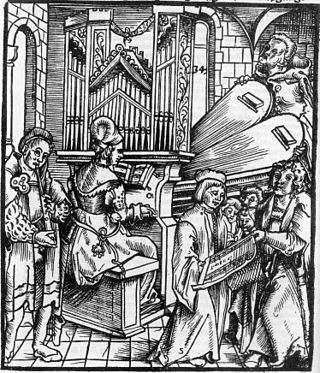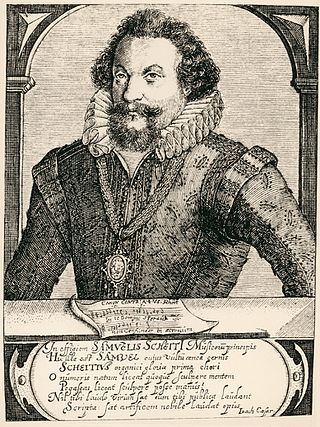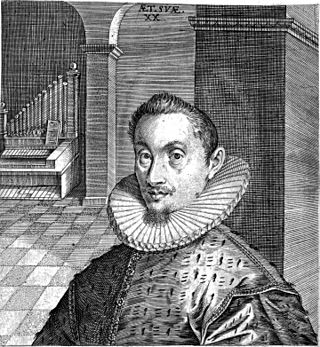Related Research Articles

Ludwig Philipp Albert Schweitzer was an Alsatian polymath. He was a theologian, organist, musicologist, writer, humanitarian, philosopher, and physician. A Lutheran minister, Schweitzer challenged both the secular view of Jesus as depicted by the historical-critical method current at this time, as well as the traditional Christian view. His contributions to the interpretation of Pauline Christianity concern the role of Paul's mysticism of "being in Christ" as primary and the doctrine of justification by faith as secondary.
Johann Pachelbel was a German composer, organist, and teacher who brought the south German organ schools to their peak. He composed a large body of sacred and secular music, and his contributions to the development of the chorale prelude and fugue have earned him a place among the most important composers of the middle Baroque era.

Charles-Marie-Jean-Albert Widor was a French organist, composer and teacher of the mid-Romantic era, most notable for his ten organ symphonies. His Toccata from the fifth organ symphony has become one of the best known and most often performed works for organ.

The pipe organ is a musical instrument that produces sound by driving pressurized air through the organ pipes selected from a keyboard. Because each pipe produces a single pitch, the pipes are provided in sets called ranks, each of which has a common timbre and volume throughout the keyboard compass. Most organs have many ranks of pipes of differing timbre, pitch, and volume that the player can employ singly or in combination through the use of controls called stops.

Arnolt Schlick was a German organist, lutenist and composer of the Renaissance. He is grouped among the composers known as the Colorists. He was most probably born in Heidelberg and by 1482 established himself as court organist for the Electorate of the Palatinate. Highly regarded by his superiors and colleagues alike, Schlick played at important historical events, such as the election of Maximilian I as King of the Romans, and was widely sought after as organ consultant throughout his career. The last known references to him are from 1521; the circumstances of his death are unknown.

Samuel Scheidt was a German composer, organist and teacher of the early Baroque era.

Hans Leo Hassler was a German composer and organist of the late Renaissance and early Baroque eras, elder brother of less known composer Jakob Hassler. He was born in Nürnberg and died in Frankfurt am Main.
Hieronymus Praetorius was a Northern German composer and organist of the late Renaissance and early Baroque whose polychoral motets in 8 to 20 voices are intricate and vividly expressive. Some of his organ music survives in the Visby Orgel-Tabulatur, which dates from 1611.

Paul Hofhaimer was an Austrian organist and composer. He was particularly gifted at improvisation, and was regarded as the finest organist of his age by many writers, including Vadian and Paracelsus; in addition he was one of only two German-speaking composers of the time who had a reputation in Europe outside of German-speaking countries. He is grouped among the composers known as the Colorists.
Leonhard Kleber was a German organist, and probably composer, of the Renaissance.

Johann Sebastian Bach was a German composer and musician of the late Baroque period. He is known for his orchestral music such as the Brandenburg Concertos; instrumental compositions such as the Cello Suites; keyboard works such as the Goldberg Variations and The Well-Tempered Clavier; organ works such as the Schubler Chorales and the Toccata and Fugue in D minor; and vocal music such as the St Matthew Passion and the Mass in B minor. Since the 19th-century Bach revival he has been generally regarded as one of the greatest composers in the history of Western music.

Harald Vogel is a German organist, organologist, and author. He is a leading expert on Renaissance and Baroque keyboard music. He has been professor of organ at the University of the Arts Bremen since 1994.
The decade of the 1530s in music involved some significant events, publications, compositions, births, and deaths.

Hans Buchner was an important German organist and composer.
Tandernaken, al op den Rijn was once a very popular Middle Dutch song about two girls who in Andernach, a city in Germany on the left Rhine bank, were spied on by the lover of one of the girls, who was listening to their conversation on love affairs from a distance.
Fridolin Sicher was a Swiss composer and organist of the Renaissance. He was born in Bischofszell and began his study of the organ at the age of 13 with Martin Vogelmaier, the organist of Konstanz Cathedral. He then studied theology and in 1510 became a prebend and organist at St Agnes Church in Bischofszell. He later returned to Konstanz for further study with Hans Buchner. Sicher went on to become the organist of the collegiate church of St Gallen and of St Michael's Church in Ensisheim. He returned to Bischofszell in 1537, where he was made both organist and chaplain of St Agnes Church.
Wolfgang Dachstein (1487–1553) was a German organist, composer, and lyricist.

"An Wasserflüssen Babylon" is a Lutheran hymn by Wolfgang Dachstein, which was first published in Strasbourg in 1525. The text of the hymn is a paraphrase of Psalm 137. Its singing tune, which is the best known part of the hymn and Dachstein's best known melody, was popularised as chorale tune of Paul Gerhardt's 17th-century Passion hymn "Ein Lämmlein geht und trägt die Schuld". With this hymn text, Dachstein's tune is included in the Protestant hymnal Evangelisches Gesangbuch.
Church music during the Reformation developed during the Protestant Reformation in two schools of thought, the regulative and normative principles of worship, based on reformers John Calvin and Martin Luther. They derived their concepts in response to the Catholic church music, which they found distracting and too ornate. Both principles also pursued use of the native tongue, either alongside or in place of liturgical Latin.

Throughout the 18th century, the appreciation of Johann Sebastian Bach's music was mostly limited to distinguished connoisseurs. The 19th century started with publication of the first biography of the composer and ended with the completion of the publication of all of Bach's known works by the Bach Gesellschaft. A Bach Revival had started from Mendelssohn's performance of the St Matthew Passion in 1829. Soon after that performance, Bach started to become regarded as one of the greatest composers of all times, if not the greatest, a reputation he has retained ever since. A new extensive Bach biography was published in the second half of the 19th century.
References
- ↑ Gillespie, John (2013-04-09). Five Centuries of Keyboard Music. Dover Publications. p. 25. ISBN 978-0-486-31879-0.
- ↑ Bertoglio, Chiara (2017-03-06). Reforming Music: Music and the Religious Reformations of the Sixteenth Century. Walter de Gruyter. p. 294. ISBN 978-3-11-052081-1.
- Brockhaus Riemann Musiklexikon , vol. 2, p. 330. 2004, digibib.